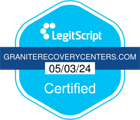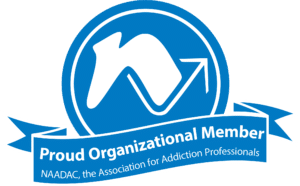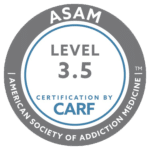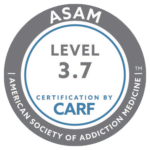Addiction and the Brain
As with any human behavior, the brain plays a leading role in addiction. Chronic substance use alters the brain’s normal functioning, especially concerning the neurotransmitter dopamine. Drugs and alcohol send a surge of stimulus to the cluster of nerves below the cerebral cortex called the nucleus accumbens, causing a flood of dopamine to be released. Research has shown that high levels of stimulation and increased pleasure sensation powerfully encourages the repetition of behaviors and habits that become deeply rooted and self-perpetuating. This overstimulation progressively weakens nerve pathways and connectivity, leading to impaired judgment, decision-making, and impulse control. Freedom of choice diminishes, and the brain becomes highly focused on seeking the substance of choice. Addiction hijacks the brain, and what may have begun as a choice becomes a prison.
What is Addiction?
Addiction, or substance use disorder, is a “psychological or physical dependency” (often both) on drugs and alcohol. Addiction is characterized by uncontrollable drug use and has been defined as a “chronic, relapsing disorder.” However, the term can also apply to behavioral disorders like sexual or gambling addictions. Individuals suffering from this disorder exhibit behaviors of compulsively seeking their drugs of choice even when doing so has detrimental or even deadly consequences.
The medical community considers addiction a brain disorder because it changes how the brain’s circuit’s function. For example, addiction inhibits people’s ability to control themselves, alters their reactions to stress, and diminishes their capacity to respond to other rewards. These effects may not be permanent, but they can last long after the person stops using the substance.
Addiction inhibits the brain’s ability to function normally. From this point of view, addiction is comparable to diseases, such as diabetes and heart conditions. They all prevent organs in the body from regular and healthy functioning. This interference can be harmful and sometimes deadly, but addiction is a treatable disorder. If addiction remains untreated, the changes in the brain can last for years or even decades. Treatment can prevent addiction leading to death.
As the brain becomes addicted to a substance, the user begins to experience symptoms. For example, substances use causes intoxication. However, if the substance becomes unavailable in some way, the user will start to experience withdrawal symptoms. Over time the user will also develop a tolerance.
When a substance is used for a long time, it is common for the user to develop a tolerance. Developing tolerance to a substance refers to its effects lessening as a result of prolonged use. For example, a substance that initially resulted in an extreme high inevitably becomes less satisfying when used chronically. To experience the same high, the user needs more and more of the substance. Tolerance also increases the frequency of the need to use. Although tolerance is not the same as addiction, it often leads to addiction. The medical description of a disease is when changes within the body lead to negative symptoms, which accurately describes addiction.
Many people do not believe that addiction is a disease of the brain. Instead, they think people become addicted to substances because they lack the willpower to overcome addiction. Others believe that addiction is a moral failing, which leads to the question, “Why don’t they just stop using?” These beliefs are fueled by stories about people who have been able to stop ingesting a substance without the benefit of a treatment center, but most people do not fit into this category.
The First Time
The first time that people ingest a substance is indeed a voluntary act. However, when a substance is used regularly over an extended period, it changes the wiring of the brain, and eventually, using becomes involuntary. As a result, the brain’s circuitry is altered, and the user’s ability to exert self-control becomes seriously impaired. This occurrence is a significant factor that leads to addiction.
Brain imaging studies have been able to demonstrate that this is true. Scientists have placed people addicted to substances into a brain imaging machine and found that there were changes in the areas of the brain that dealt with behavior control, memory, learning, decision-making, and judgment. These changes cause people to act impulsively when seeking their drugs of choice.
How a Brain Normally Works
The human brain is comprised of billions of cells called neurons. Neurons are organized into circuits and networks. Each neuron controls the flow of information. When a neuron receives multiple signals from connected neurons, it sends a signal out to other neurons in the circuit.
The brain’s interconnected circuits work as a team. For example, a circuit will be in charge of performing a specific function. These neurons send signals back and forth to each other and other parts of the brain. They also send messages to the nerves and the spinal cord.
To send a message, a neuron must release a neurotransmitter. But first the neurotransmitter crosses the space or “synapse” between the sending and receiving neurons. After crossing the synapse, the neurotransmitter becomes attached to the next neuron, and the neuron that receives the neurotransmitter changes.
The Way the System Works with Substances
When substances are present, neurons cannot send, receive, and process signals from neurotransmitters as they usually do. However, if the chemical structure of a substance is like the brain’s neurons, it can activate them, but it will activate them differently than the neurons ordinarily would. Therefore, substances begin to send abnormal messages throughout the body.
If the substance is cocaine or methamphetamine, it causes neurons to release vast amounts of the brain’s natural neurotransmitters. This interferes with the job of the brain’s transporters, which is to take neurotransmitters that have been released back into the neuron that released them. This limits the number of signals that neurons send to each other. With this interference, the neurons cannot normally communicate with each other.
Dopamine’s Role in the Addiction Process
When a human experiences pleasure, the brain knows that the activity that created the pleasure is something it wants to encourage the person to do repeatedly. In a healthy brain and body, the activities are also healthy and beneficial to the human being. So, the brain uses dopamine to increase the likelihood of people repeating positive behaviors. Dopamine is a neurotransmitter that the reward circuit releases.
After people engage in a pleasurable experience, dopamine surges so that the brain and body will remember that something significant has just occurred. As dopamine surges throughout the brain, its neural connectivity changes, making it much easier for the person to act repeatedly without thinking about it. When this occurs, a habit has just been formed.
Along with euphoria, substances also cause the brain to release copious amounts of dopamine, so consuming the substance becomes attached to the resulting pleasure and everything that went into obtaining the substance. In addition, these dopamine surges teach the brain to choose to seek out the person’s substance of choice rather than engage in activities that are healthier for them.
When people addicted to substances encounter the things that have become attached to the euphoria of substance use, the person’s reward circuit releases cravings that are too strong for the person to ignore. The substance does not need to be within the person’s reach. This reflex can remain with those addicted to substances for many years. For example, someone may have been addicted to heroin but overcame the addiction several years ago. If this person returns to the neighborhood where they engaged in heroin use, they may experience cravings.
Drug and Alcohol Overdose Statistics
Overdose deaths in the United States have increased annually for over two decades. In 2021, there were 106,699 overdose deaths in the U.S. This is a vast increase from roughly 19,000 overdose deaths in 1999. From 1999-2021 over one million overdose deaths have occurred in the United States.
Many are under the impression that substance abuse and overdose deaths decreased during the COVID-19 pandemic. However, the very opposite is true. The U.S. experienced its highest-ever increase in overdose deaths in the first year of the pandemic. In 2020 the rate of fatal overdoses rose by 30%, with nearly 92,000 lives lost.
A Guide to Withdrawal
The detox period, also referred to as “withdrawal,” involves a combination of physical and psychological responses to suddenly stopping or reducing the use of a substance on which the body has become dependent. The brain and body need to maintain a state of equilibrium (homeostasis) or balance. Prolonged substance use affects the brain’s reward system and impacts this balance. When the body and brain have become dependent on a substance, and that substance begins to recede from the system, the balance is thrown off, and withdrawal symptoms begin.
Withdrawal symptoms can differ significantly depending on the substance or substances. Symptoms can range from mild to severe and even life-threatening. Physical symptoms of substance withdrawal may include dizziness, headaches, nausea and vomiting, muscle aches and tension, twitches, tremors, and shakes. Psychological withdrawal symptoms can include anxiety and panic attacks, irritability, difficulty falling and staying asleep, confusion, fatigue, depression, and thoughts of suicide. The most dangerous withdrawal symptoms include heart attacks, strokes, delirium tremens (DTs), seizures, and hallucinations.
If your body has become dependent on a substance or substances, you have likely experienced withdrawal symptoms at some point. And the idea of going through the full withdrawal process can be intimidating and seem impossible, but with help, there is hope. Drug and alcohol detox programs offer support and care, and medical detox programs provide medications to help ease withdrawal symptoms and prevent potential complications.
As the name implies, medical detox is supported by medical doctors and other medical professionals. At Granite Recovery Centers, we pride ourselves on knowing recovery inside and out and understand that while the detox process is no cakewalk, the road to recovery begins. Our medically supervised detox options make the withdrawal process as comfortable and manageable as possible.
Types of Treatment Available
Detox programs help people get clean. However, in order to remain clean, most people require further treatment. Granite Recovery Centers treatment programs provide a full continuum of care utilizing a hands-on treatment approach. Our process is comprised of two major components: evidence-based clinical psychotherapies in conjunction with our 12-Step based R.E.S.T. program.
Wellness Recovery Action Plan “WRAP’
The Wellness Action Recovery Plan®, or WRAP®, is a prevention process for anyone seeking to change themselves and their lifestyle. WRAP® is an evidence-based program primarily focused on substance use, mental health, and co-occurring disorders. The WRAP® program has been researched and thoroughly examined to ensure its accessibility and effectiveness, and it is a go-to source for relapse prevention planning and execution.
Cognitive-Behavioral Therapy (CBT)
Cognitive-behavioral therapy is a commonly practiced evidenced–based therapy process that can help people in many ways. CBT focuses on teaching clients skills that will allow them to identify and interrupt ineffective and negative thought patterns. The aim is to change automatic negative thinking processes and provide the opportunity to make better decisions in times of stress, frustration, and other challenges.
Seeking Safety
Seeking Safety is an evidence-based model used for treating co-occurring post-traumatic stress disorder (PTSD) and substance use disorder. The main objective of this treatment model is for clients to learn how to establish safety, hence its name. The curriculum addresses a new topic every week, covering subjects such as Grounding, Asking for Help, Compassion, and Coping Skills that will help clients learn to understand and manage their disorders.
Illness Management and Recovery (IMR)
Illness Management and Recovery (IMR) is a curriculum-based rehabilitation program developed and published by Substance Abuse Mental Health Services Administration, “SAMHSA,” for co-occurring substance use and mental health disorders. This evidence-based practice aims to improve self-management skills for short and long-term remission.
Recovery Education and Skills Training (R.E.S.T.)
R.E.S.T. is a comprehensive lecture, discussion, and action-based curriculum integrating 12-Step principles with evidence-based clinical practices and the personal experiences of men and women in recovery. R.E.S.T. is a five-level structured program with principles established from each level building upon the levels before. As clients progress, the format of R.E.S.T. presents fewer lectures and more discussion-based material. This allows clients to identify with the material inwardly and verbally express that identification along with any questions, comments, and concerns. Clients will eventually be given the opportunity for self-examination through an individualized therapeutic writing process. The final portion of the R.E.S.T. curriculum focuses on past and present resentments and other unresolved feelings.
Is Treatment a Cure?
Addiction is a chronic disease that cannot be cured but can be treated successfully. Treatment means you can stop the harmful effects of substance use on your brain. Then, you will be fully capable of taking over your life again.
Addiction is a relapsing disorder, so it isn’t surprising that some people return to substance use. However, relapsing is a part of the recovery process. The key is to continue with treatment. When you do, you are less likely to relapse in the future.
Addiction doesn’t have to have an unhappy ending. Although treatment is not a cure, it can help you or your loved one live a productive life. At Granite Recovery Centers, we will treat your substance use and mental health disorders if you have one. We offer you a stay in our inpatient or outpatient program, and when you are finished with treatment, we can place you in our alumni program.
If you are seeking treatment or have questions you would like answered, we are available 24/7 at 855.712.7784 or through our contact form.






